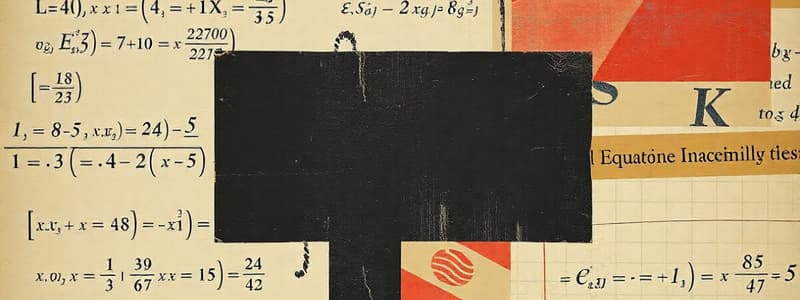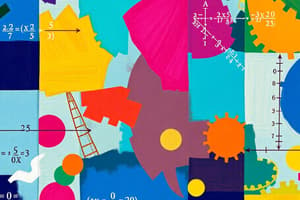Podcast
Questions and Answers
العمليات في الجبر تشمل الجمع والطرح فقط.
العمليات في الجبر تشمل الجمع والطرح فقط.
False (B)
المعادلات الخطية تمثل خطًا مستقيمًا على الرسم البياني.
المعادلات الخطية تمثل خطًا مستقيمًا على الرسم البياني.
True (A)
الجذور التربيعية لمعادلة هي نفس الجذور التربيعية للمعادلة الخطية.
الجذور التربيعية لمعادلة هي نفس الجذور التربيعية للمعادلة الخطية.
False (B)
يمكن أن تحتوي الحدود في كثيرات الحدود على متغيرات وثوابت مختلطة.
يمكن أن تحتوي الحدود في كثيرات الحدود على متغيرات وثوابت مختلطة.
تتم عملية تحليل كثيرات الحدود عن طريق جمع حدودها.
تتم عملية تحليل كثيرات الحدود عن طريق جمع حدودها.
صورة المعادلة التربيعية هي ax² + bx + c = 0.
صورة المعادلة التربيعية هي ax² + bx + c = 0.
تمثل المصفوفات طريقة لحل أنظمة من المعادلات.
تمثل المصفوفات طريقة لحل أنظمة من المعادلات.
الخصائص التجميعية تخبرنا أن ترتيب الأعداد في الضرب لا يؤثر على النتيجة.
الخصائص التجميعية تخبرنا أن ترتيب الأعداد في الضرب لا يؤثر على النتيجة.
كل دالة يمكن أن تعيد أكثر من قيمة ناتجة لكل قيمة مدخلة.
كل دالة يمكن أن تعيد أكثر من قيمة ناتجة لكل قيمة مدخلة.
تمثل الجذور أو الجذور النونية للعدد في التعبيرات الأسية.
تمثل الجذور أو الجذور النونية للعدد في التعبيرات الأسية.
Flashcards
معادلة خطية
معادلة خطية
تمثل معادلة خطية خطًا مستقيمًا على الرسم البياني. عادةً ما تكون على شكل س + ب = 0. حيث س هو المتغير، و أ و ب ثوابت.
متغير
متغير
يمثل قيمة غير محددة أو مجهولة، غالبًا ما تُمثّل بحروف (مثل س، ص، ع).
معادلة تربيعية
معادلة تربيعية
تُعبر معادلة تربيعية عن متغير مرفوع للقوة الثانية. عادة ما تكون على شكل أ س² + ب س + ج = 0, حيث س هو المتغير، و أ، ب، ج ثوابت.
عبارة جبرية
عبارة جبرية
Signup and view all the flashcards
خاصية التوزيع
خاصية التوزيع
Signup and view all the flashcards
متعدد الحدود
متعدد الحدود
Signup and view all the flashcards
تحليل
تحليل
Signup and view all the flashcards
نظام المعادلات
نظام المعادلات
Signup and view all the flashcards
المصفوفات
المصفوفات
Signup and view all the flashcards
الدوال
الدوال
Signup and view all the flashcards
Study Notes
Fundamental Concepts
- Algebra is a branch of mathematics that deals with symbols and the rules for manipulating those symbols. These symbols, often letters, represent numbers or unknown quantities.
- It provides a systematic way to solve equations and inequalities and analyze relationships between variables.
- Key elements in algebra include variables, constants, coefficients, expressions, equations, and inequalities.
Variables and Constants
- Variables represent unknown or unspecified quantities. They are usually represented by letters (e.g., x, y, z).
- Constants represent fixed or specific numerical values.
Expressions
- Algebraic expressions combine variables, constants, and mathematical operations (addition, subtraction, multiplication, division, etc.).
- Evaluating an expression means finding its value when the variables are given specific numerical values.
Equations
- Equations state that two expressions are equal. Solving an equation means finding the values of the variables that make the equation true.
- Different types of equations exist, including linear equations, quadratic equations, and polynomial equations.
- An important goal in algebra is solving for unknown variables.
Inequalities
- Inequalities state that two expressions are not equal. They use symbols like > (greater than), < (less than), ≥ (greater than or equal to), ≤ (less than or equal to).
- Solving inequalities involves finding the values of variables that satisfy the given inequality.
Properties of Operations
- Commutative property: The order of numbers in addition or multiplication does not affect the result. (a + b = b + a, a * b = b * a)
- Associative property: The grouping of numbers in addition or multiplication does not affect the result. ((a + b) + c = a + (b + c), (a * b) * c = a * (b * c))
- Distributive property: Multiplication distributes over addition. a * (b + c) = a * b + a * c
Linear Equations
- Linear equations represent a straight line on a graph.
- They typically have the form ax + b = 0, where 'a' and 'b' are constants and 'x' is the variable.
- Solving a linear equation involves isolating the variable.
Quadratic Equations
- Quadratic equations involve a variable raised to the power of 2.
- They are commonly written in the form ax² + bx + c = 0, where 'a', 'b', and 'c' are constants.
- Methods for solving quadratic equations include factoring, completing the square, and the quadratic formula.
Polynomials
- Polynomials are algebraic expressions consisting of variables and coefficients combined using addition, subtraction, and multiplication.
- They include different types of terms (monomials, binomials, trinomials) which are distinguished by how many terms they contain.
Factoring
- Factoring is the process of expressing a polynomial as a product of other polynomials.
- This is important for simplifying expressions and solving equations.
Systems of Equations
- A system of equations comprises multiple equations involving more than one variable.
- Techniques to solve such systems include substitution, elimination, and graphical methods. Finding where the graphs of the equations intersect gives the solution.
Matrices
- Matrices are rectangular arrays of numbers or functions. They are used to solve systems of equations, and represent transformations in various applications like linear programming and computer graphics.
Functions
- Functions relate inputs to outputs. Formally a function is a relation where each input value (x) corresponds to exactly one output value (y).
- Fundamental concepts of functions include domain and range.
Exponents and Radicals
- Exponents represent repeated multiplication.
- Radicals represent roots or nth roots of numbers.
Word Problems
- Many algebraic concepts are applied in solving real-world problems.
- Mathematical models for word problems often involve the use of algebraic techniques.
Studying That Suits You
Use AI to generate personalized quizzes and flashcards to suit your learning preferences.




